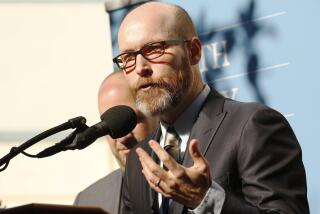Dixon Gets 5 Years for Fraud in Thrift Collapse : Thrifts: Federal officials were shocked by the short sentence. The former owner of Vernon S&L; must also pay restitution.
- Share via
Donald R. Dixon, the most visible of the Texas savings and loan renegades convicted of looting the industry in the 1980s, was sentenced Tuesday to five years in prison for fraud--an unexpectedly light penalty that shocked federal officials.
Office of Thrift Supervision Director Timothy Ryan, the nation’s top thrift regulator, called Dixon’s sentence “very disappointing” and suggested that the sentence could hurt efforts by authorities to punish S&L; crooks.
“It is a small price to pay given the damage Mr. Dixon did to the thrift industry. Substantial sentences are required to provide punishment commensurate with the losses to taxpayers and to deter similar conduct in the future,” Ryan said.
Dixon was targeted for prosecution for using Vernon Savings & Loan in the mid-1980s as his “personal piggy bank.” The thrift funded a lavish lifestyle for Dixon, including a $22,000 tour of the best European restaurants, San Diego-area beach homes and $1,000-a-night call girls for his associates.
Atty. Gen. Dick Thornburgh once called Dixon the “highest of the high fliers among the savings and loan crooks.” Dixon, 51, was convicted of 23 counts of fraud in December stemming from the mishandling of $41 million in loans and misusing funds to finance his lifestyle. He faced a maximum sentence of 120 years in prison and a $5.75-million fine.
A stiff sentence had been expected in part because Vernon’s Chairman, Woody F. Lemons, whom authorities consider far less responsible than Dixon for Vernon’s collapse, received a 30-year prison term last year after he was convicted of 13 fraud counts.
But U.S. District Judge Joe Fish, who also ordered Dixon to repay $611,000 to the Federal Deposit Insurance Corp., told the courtroom that Dixon should not be punished for Vernon’s $1.3-billion failure. Fish said prosecutors did not prove it and suggested that Dixon might be the victim of “lynch mob mentality.”
Dixon pleaded for leniency and asked Fish “for an opportunity to restitute some of the cost to the American taxpayer” for his role in the nation’s savings and loan debacle. He was ordered to perform 500 hours of community service as part of the sentence.
Justice Department spokesman Doug Tillett would not directly criticize the sentence, but it was clear from his comments that the department is disappointed.
“If you want to draw your own implications, we tried Woody Lemons and we convicted him. We recommended and got a substantial sentence of 30 years. Dixon’s criminal activity was in the same institution,” Tillett said.
Edwin J. Gray, who was the nation’s top savings and loan regulator when authorities first began cracking down on Vernon in 1986, reacted in disbelief when told Fish said Dixon should not be held responsible for Vernon’s collapse.
“If not Don Dixon, then who? And why not Don Dixon?” Gray asked.
Dixon bought a sleepy savings and loan in his hometown of Vernon, Tex., for $5.8 million in 1982, soon embarking on a spending spree that has become the stuff of savings and loan legend. He gave the Pope a $40,000 painting that belonged to Vernon. In 1983, the savings and loan paid to send Dixon, his wife and another a couple on a 10-day culinary tour of Europe that Dixon’s wife dubbed “gastronomique fastastique” in her diary.
Dixon forged close ties with such politicians as former House Speaker Jim Wright, who spoke to regulators on Dixon’s behalf, and former California Rep. Tony Coelho.
Vernon collapsed in March, 1987, with a staggering 96% of its $1.4 billion in assets in default.
More to Read
Inside the business of entertainment
The Wide Shot brings you news, analysis and insights on everything from streaming wars to production — and what it all means for the future.
You may occasionally receive promotional content from the Los Angeles Times.










